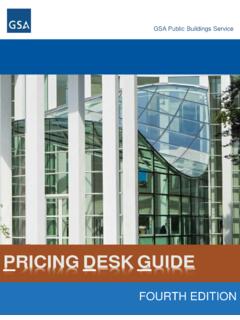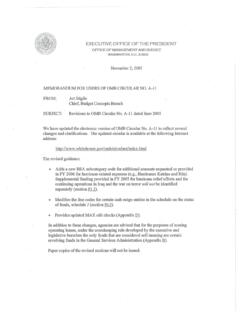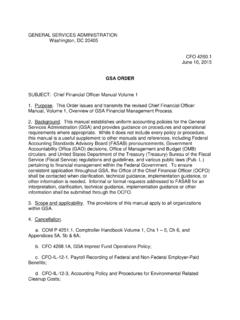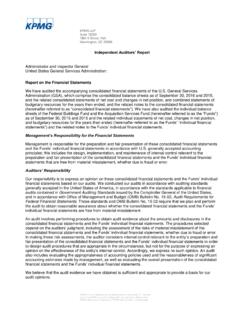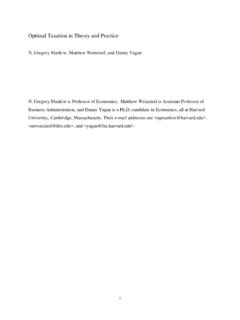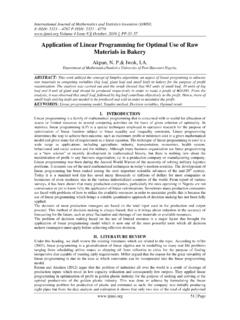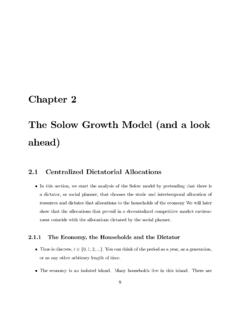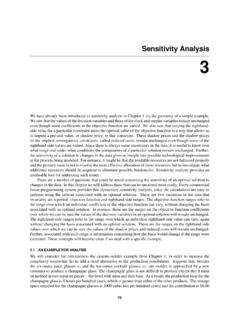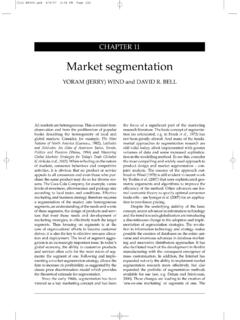Transcription of Workspace Utilization and Allocation Benchmark
1 GSA Office of Governmentwide PolicyWorkspace Utilization and Allocation Benchmark Office of Real Property Management Performance Measurement DivisionWorkspace Utilization and Allocation Benchmark Workspace Utilization and Allocation Benchmark General Services Administration Office of Governmentwide Policy Office of Real Property Management Performance Measurement DivisionJuly 2011 Note: Effective as of July 2012, the author has updated the Workspace Benchmark data. 1 Workspace Utilization and Allocation BenchmarkContentsIntroduction ..3 Methodology ..7 Research Analysis ..9 Federal Workspace Policy and Regulations ..13 The Emerging Workspace ..15 Workspace Survey Results ..23 Workspace Allocation Results ..25 Workplace Snapshots Benchmark #1: Business Services/Consulting ..27 Benchmark #2: Telecommunication ..28 Benchmark #3: Manufacturing.
2 28 Benchmark #4: Domestic Government Organization ..29 Benchmark #5: International Government Organization ..29 Benchmark #6: Academic Institution ..30 Benchmark #7: Diversified Manufacturer ..30 Benchmark #8: Media Conglomerate ..31 Benchmark #9: Business Services/Consulting ..31 Case studies: Today s Innovative Workplace ..32 Case Study #1: IBM Reduces Its Real Estate Footprint Through Telework ..32 Case Study #2: Sabre s Workplace Innovation ..34 Case Study #3: Herman Miller on Space Standards and Industry Trends ..35 Featured Article: Take my desk please ..37 Acronyms ..433 Workspace Utilization and Allocation Benchmarkanaging and allocating office Workspace is a constant challenge for both public and private organizations. This challenge exists because organizations have to meet functional space demands using limited resources. When determining the best way to forecast and allocate Workspace and support knowledge workers, today s architects, designers, facilities and real estate professionals, and workplace consultants must consider the following factors: Space availability; Energy costs; Operation and maintenance costs; Ever-changing mission requirements; Security concerns; Emergency management planning; Alternative workplace arrangements (AWA); and The new mobile the past decade, the Federal government has moved away from strict hierarchical space use standards based on pay grade or associate position.
3 The Federal government now follows the Code of Federal Regulation s (CFR) recommendations for space planning based on organizational needs1. Current Workspace regulations state that Executive agencies must provide a quality workplace environment that supports program operations, preserves the value of real property assets, meets the needs of the occupant agencies, and provides child care and physical fitness facilities in the workplace when adequately justified. An Executive agency must promote maximum Utilization of Federal Workspace , consistent with mission requirements, to maximize its value to the Government. 2 When assigning and utilizing federal Workspace , Executive agencies must provide assignment and Utilization services that will maximize the value of Federal real property resources and improve the productivity of the workers housed therein.
4 3 With respect to the Code of Federal Regulations, the General Services Administration (GSA), Office of Governmentwide Policy (OGP) provides additional guidance to promote government-wide cost-effective, flexible and quality Workspace . This Workspace Utilization and Allocation Benchmark publication presents a concise synopsis of Workspace research findings and practical recommendations. OGP s Introduction1 GPO Access, Code of Federal Regulations Main Page: Federal Management Regulation: Assignment and Utilization of Space, Title 40 Code of Federal Regulations, Part Federal Management Regulation: Assignment and Utilization of Space, Title 40 Code of Federal Regulations, Part Utilization and Allocation Benchmarkobjective is to present this information to the entire Federal community with the hope that it leads to more informed decision-making and better overall Utilization and Allocation of office Workspace .
5 Many real estate managers and facility managers are interested in developing similar programs or extending existing programs in support of real estate cost savings goals, Workspace consolidation plans and GSA s Zero Environmental Footprint (ZEF) initiatives. This publication shares challenges and best practices with real estate professionals and facility managers across all addition to providing useful recommendations, this 2011 Workspace Utilization and Allocation Benchmark publication includes the GSA Office of Governmentwide Policy Workspace Benchmark and a feature article on space planning methods used by an internationally-known private sector firm. This research review also includes ten arbitrarily selected Benchmark studies and three case studies. The case studies explain how these organizations which range from information technology firms to real estate corporations utilize space planning to get the most out of their Utilization and Allocation Benchmarkhe Federal government is a collection of diverse agencies with differing missions.
6 Therefore, the task of developing or confirming a government-wide standard for office Workspace use per person is a significant challenge and not the premise of this Benchmark publication. GSA presents this information to the entire Federal community with the hope that it leads to a more effective, efficient Workspace environment that accommodates individual work styles and alternative workplace strategies to reduce office Workspace developed this comprehensive study with our real property colleagues to promote the most efficient and optimal use of office Workspace for both Federal agencies and the private sector. A wide variety of public and private sector organizations are represented in this study, including Federal agencies, international sector organizations, financial services, information technology, technology consulting, management consulting, real estate services, media services and the summer of 2010, through the winter of 2011, GSA conducted a Workspace Utilization survey, analyzed data results, conducted Internet research, and held telephone interviews with several public and private organizations.
7 GSA attended several leading industry workplace conferences to identify and gain insight into emerging contemporary trends, practices, and standards in Workspace Utilization and Allocation . GSA collected data to produce three case studies and ten workplace benchmarks, which explain each organization s workplace space usage in greater detail. GSA also reviewed numerous published sources and other publicly available information including industry best practice publications, government-wide policy bulletins, press releases, and industry surveys to examine new government and private sector space Allocation Utilization and Allocation BenchmarkResearch Analysis Our customers are struggling with higher real estate costs, so they re looking for ways to reduce the amount of gross square footage allotted to each person. ~ Cheri Bromberg, Steelcase application design specialistThis section outlines findings of Workspace use practices and trends based on GSA s research and contact with professional trade organizations, private sector firms, and Federal agencies, as well as national, international, state and local found that the emphasis on workplace space use trends has changed tremendously since our initial 1997 Office Space Use Review: Current Practices and Emerging Trends and our 2002 Space Use Update.
8 Federal agencies and private sector organizations have been forced to constantly reevaluate their current Workspace usage. Workplaces are now influenced by an improving mobile workforce and greater use of instantaneous wireless communication tools. Mobile phones, smart phones, BlackBerry devices and wireless networking have revolutionized the workplace. As a result, many Federal agencies and private organizations have turned to alternative work environments to reduce Workspace costs and optimize physical work environments including telework, hoteling stations and desk sharing, are a major trend in today s real estate marketplace, and offer organizations flexibility and optimal Workspace usage. Additionally, organizations have noted an increase of quantitative benefits with the use of alternative work environments such as increased productivity and enhanced associate apply different space use measurements, which presented a challenge when comparing workplace space use for the many participating organizations.
9 For example, some organizations measure Workspace in Rentable Square Feet (RSF), or the gross square footage minus vertical penetrations (such as stairwells and elevator pipe shafts). Others measure Workspace by Usable Square Feet (USF), or the sum of retail areas, office The Workspace Benchmark average in this study is based primarily on a square foot per person , and common areas. Neither RSF nor USF standards simply measure an associate s office or cubicle area, but also include a portion of shared space such as conference rooms and hall space for each associate in a space use organizations also differed in their space per person reporting method. Some organizations reported a space per person standard based on workers positions or functions, while others use a uniform, organization-wide space per person designation. Some organizations did not identify their measurement method, so GSA tried to resolve the reporting issues by working with participating organizations to generate and standardize comparable data.
10 In most cases, GSA adjusted percentages between RSF and USF, as agreed upon by the organization on public sector data information of office Workspace use trends, organizations were allocating a prevailing standard Workspace average of 190 Usable Square Feet (218 Rentable Square Feet) as the optimum Workspace per person. Organizations can most efficiently and effectively minimize their square foot usage by implementing innovative Workspace strategy, such as hoteling and for example has been knocking down walls, even dismantling cubicles to create a free-flowing layout that encourages collaboration and reduces Workspace . When renovation of GSA s Washington headquarters is completed in 2013, the building will accomodate 4,500 workers almost 2,000 more than a year ago because of shared work spaces and telecommuting. GSA Headquarter office will average approximately 80 USF (92 RSF) per person of Findings1.


